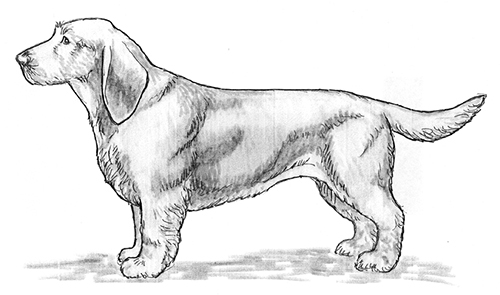Basset Fauve de Bretagne
Scenthound Group
The goals and purposes of this breed standard include: to furnish guidelines for breeders who wish to maintain the quality of their breed and to improve it; to advance this breed to a state of similarity throughout the world; and to act as a guide for judges.
Breeders and judges have the responsibility to avoid any conditions or exaggerations that are detrimental to the health, welfare, essence and soundness of this breed, and must take the responsibility to see that these are not perpetuated.
Any departure from the following should be considered a fault, and the seriousness with which the fault should be regarded should be in exact proportion to its degree and its effect upon the health and welfare of the dog and on the dog’s ability to perform its traditional work.
History
The Basset Fauve de Bretagne originated in France for use as a scenting hound on rabbit, hare, fox, roe deer and wild boar. It is a descendant of the larger Griffon Fauve de Bretagne. The breed has been popular as a hunter in its native region since the 19th Century, and earned a national reputation as an outstanding rabbit hound during the latter part of the 20th Century.
The Basset Fauve de Bretagne was recognized by the United Kennel Club on January 1, 1996.
General Appearance
A small, stocky hound, rectangular in shape, the Basset Fauve de Bretagne is rough coated and fawn in color. It is a very hardy breed, energetic and fast for its size.
Characteristics
Smart, courageous and determined, the Basset Fauve de Bretagne is a serious hunter, easily adapting to different types of game or terrain. It is also an excellent companion, being cheerful, friendly and agreeable.
Serious Fault: Timidity.
Head
SKULL
Rather long, and broadest between the ears, tapering in width to the eyes. Slightly flattened on top, arched on the sides. Stop is moderate, but a little more than in the Griffon Fauve de Bretagne.
MUZZLE
Same length as the skull, tapering slightly in width from the stop to the nose. Lips well cover the lower jaw, but there is no excess of flew. Hair covering (moustache) is moderate.
TEETH
Strong teeth meet in a tight scissors bite. The absence of the first premolars is not faulted.
EYES
Set well into the skull, neither prominent nor too deep, with no haw visible. Dark brown in color. Expression is lively. Rims are fully pigmented.
NOSE
Black or dark brown, with well-opened nostrils. Fully pigmented.
EARS
Drop ears are set low, on a line with the eye. When pulled forward, they reach just to the end of the nose. The ears taper to a point at the end and turn inwards. They are covered with shorter, softer hair than that on the rest of the dog.
Neck
Rather short and well-muscled. No dewlap.
Forequarters
Shoulders are obliquely placed.
FORELEGS
Legs have good bone. Elbows are held close to the body. Legs are preferably straight from elbow to foot, but a slight curve in the forearm is allowed. Pasterns slope slightly. Distance from elbow to ground is slightly less than distance from withers to elbow.
Body
Deep and broad, with moderately rounded ribcage. Back is rather short for a Basset, broad, strong and level. Loin is wide and muscular with little tuck-up.
Serious Faults: Frail appearance, sway backed, too much tuck-up.
Hindquarters
Well muscled, with long thighs. Moderate angulation matches that of the forequarter.
HIND LEGS
When viewed from behind, legs are straight and parallel from hip to foot. Rear pastern is short and vertical.
Feet
Compact, with well arched, tight toes and hard pads. No dewclaws on hind legs.
Tail
Medium in length, strong at the base, tapering to a point. Carried above the line of the back in sickle shape with side to side action.
Coat & Skin
The coat is very rough, harsh and not too long. Moderate facial furnishings. Skin is thick and supple.
Serious Fault: Coat sparse, soft, smooth or fine.
Color
Various shades of fawn, from golden wheaten to brick red. A few black hairs on the ears or the back are acceptable but not desirable, as is a small white spot on the chest.
Height
For both males and females, acceptable height is from 12.5 inches to 15.5 inches, with a minor variation up or down acceptable for otherwise outstanding specimens.
Gait
Lively and active.
Eliminating Faults
(An Eliminating Fault is a Fault serious enough that it eliminates the dog from obtaining any awards in a conformation event.)
Characteristics: aggressiveness or overt shyness.
Teeth: jaws overshot or undershot.
Head: totally or partially unpigmented areas on nose, eye rims or lips. Extremely light eyes. Forequarters: excessive crook in the foreleg.
Feet: presence of dewclaws on the hind legs. Tail: kinked tail.
Coat: long or woolly coat, or any coat not described by the standard. Height: more than one inch over or under the specified size.
Disqualifications
(A dog with a Disqualification must not be considered for placement in a conformation event, and must be reported to UKC.)
Unilateral or bilateral cryptorchid.
Viciousness or extreme shyness.
Albinism.

Looking for a Dog?
Find a dog that will fit your family.
Note: The breeders on this list are not endorsed by UKC.
Revised February 22, 2007
©Copyright 2006, United Kennel Club
